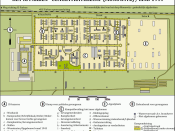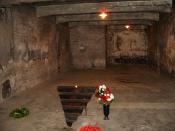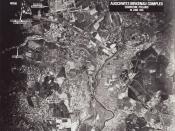Located thirty-seven miles west of Krakow, Auschwitz was the camp where Jewish people were killed and worked. This camp, out of all the rest tortured and killed the most people. The gas chambers and crematoriums were made from converted barns and houses taken from many polish people that lived nearby. The first gas chamber to be used was built in Auschwitz I. The gas that was used in the chambers was called Zyklon B. It could burn about 340 corpses a day. The gas chambers looks just like shower rooms. The prisoners were told they needed to be cleaned before work, and were then killed in the stalls. The clothes that the prisoners wore were given to new prisoners that came in.
In March of 1941, there was another camp that started to be built. This second camp was called Auschwitz II, or Birkinau. It was located 1.9 miles away from Auschwitz I.
People that were chosen to come to these camps were expelled from their homes. Their houses were destroyed for the purpose of building Birkinau. The population of Bikinau was the most densely populated out of all the camps. It also had the most cruel and bad conditions of all the camps in the complex. The prisoners at Birkinau mostly consisted of Jews, Poles, and Germans. There were a number of Gypsy and Czech Jew family camps located at Birkinau for a period of time also In Birkinau, the largest number of people that could be killed in the gas chambers was 6,000 people daily. Birkinau and all the other sub-camps were mostly forced labor camps and had over 6,000 women prisoners being held.
In the town Monowitz, another camp was being built. This camp was called Auschwitz III, or Buna-Monowitz. In September 1942, the Auschwitz III, or Buna-Monowitz building project was complete. Other camps that were located close to Monowitz were moved to Buna-Monowitz. It was the second largest complex of the three. Ninety percent of Buna-Monowitz imprisoned were homosexuals, Jehovah's witnesses and children that were fit to work. It also had a very large crematorium that could burn up to 1,440 people a day.
By January 20th, 1944, the population of the Auschwitz complexes had reached 480,839. That number rose up and up as the months past and more prisoners came. The prisoners at the camps were worked to the point of death. Trains transported people to the camps, and violently forced them off the train. All of the people's property was left on the train also. They prisoners were sent into two different lines, one for women and the other for men. The lines moved into the place were a procedure called Selection took place. The ones who could work were not killed at this time, but the women, children, and others that couldn't work were gassed. The prisoners that were to work, had their clothes taken, heads shaved, got sterilized, and were given black and white striped clothes to wear.
In the forced labor camps, the average life time was only a few months. Some of the prisoners that couldn't react or move became what was known as Muselmann. A
dreaded part of all of the camps were the roll calls (also called "selection"). During selection, prisoners were sent out into the cold night after a hard day of work, and lined up. Anyone that fell to the ground was shot or gassed. Anyone who looked weak, sick or had recently had many visits to the doctors were "selected" to go onto a large truck. Thinking that they were going onto the truck to get medical attention, they were taken to gassed and burned. One of the worst chores that many prisoners had was called the "Sonderkommando". Doing this meant that you helped burned the bodies of the dead prisoners in the crematorium. The daily routine in the complex differed in each camp, but the basic routine was the same. They: woke at dawn, cleaned their areas, morning roll call was taken, they walked to the work site, worked for long hours, had to wait in lines for food, then walked back to their bunks, block inspection was done, and then evening roll call was taken.
There were also people who got picked for medical experiments. The best known doctor at Auschwitz was Josef Mengele. His experiments were mostly done on twins, dwarfs and women. He did lots of things that had to do with seeing how long it would take a person to die if you do this or that. He mostly did experiments that had to do with cutting off body parts, and reattaching them to different parts of the body.
After many years, all of the Auschwitz camps lay in ruin. Many SS troopers destroyed their own camps to hide all of the evidence from the Russian troops. Birkinau was destroyed by the Russians in a raid to free the prisoners. Buna-Monowitz was destroyed by the SS in an attempt to hide it's existence, but was found only two weeks later by a Russian patrol squad. Although Birkinau and Buna-Monowitz were destroyed, the original Auschwitz concentration camp still remains intact today, this is because the SS was caught off guard and didn't have time to destroy the camp in time to make their escape, instead they ordered all of the Jews imprisoned there to mop all the floors of any obvious evidence and hide any objects or equipment that were used to harm or kill and prisoners.
Sixty-four years later, the Auschwitz camp is visited by people around the world that were victims or knew victims of the holocaust. Many victims that recently visited the camp say that even after sixty-four years, they can still see in their minds the people dying all around them, feel the pain on their backs from all the beatings and whippings, and smell the thick black smoke coming from the corpses of the people they knew from the crematoriums.
The history of those years from when the day the camps were taking their first prisoners, to the day when the camps were abandoned still haunt victim's minds, scare people with their horrible tales and make children gasp in history classes all around the world, now and forever more.


